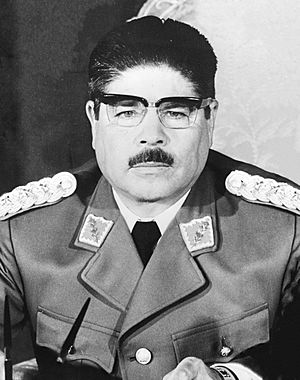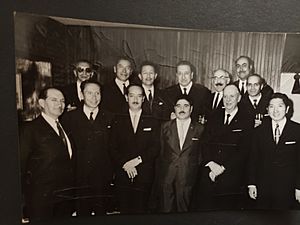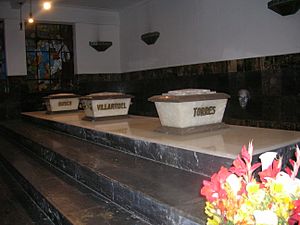Juan José Torres facts for kids
Quick facts for kids
Juan José Torres
|
|
|---|---|
 |
|
| 50th President of Bolivia | |
| In office 7 October 1970 – 21 August 1971 |
|
| Vice President | Vacant |
| Preceded by | Alfredo Ovando Candía |
| Succeeded by | Hugo Banzer |
| Minister of Work and Social Security | |
| In office 31 March 1966 – 6 August 1966 |
|
| President | Alfredo Ovando Candía |
| Preceded by | Samuel Gallardo Lozada |
| Succeeded by | Vicente Mendoza Nava |
| Minister of Finance and Statistics | |
| In office 5 November 1964 – 6 November 1964 |
|
| President | René Barrientos |
| Preceded by | Jaime Escobar Quiroga |
| Succeeded by | Carlos Alcoreza Melgarejo |
| Personal details | |
| Born |
Juan José Torres González
5 March 1920 Cochabamba, Bolivia |
| Died | 2 June 1976 (aged 56) San Andrés de Giles, Buenos Aires, Argentina |
| Cause of death | Assassination |
| Resting place | La Paz, Bolivia |
| Political party | Alliance of the National Left |
| Spouse | Emma Obleas Eguino |
| Children |
|
| Parents | Juan Torres Cueto Sabina González |
| Education | Military College of the Army |
| Signature |  |
| Military service | |
| Allegiance | |
| Branch/service | |
| Years of service | 1941–1970 |
| Rank | General |
Juan José Torres González (born March 5, 1920 – died June 2, 1976) was a military leader and politician from Bolivia. He served as the 50th president of Bolivia from 1970 to 1971. People often called him "J.J." (pronounced HOTA-HOTA). He was known for his ideas about fairness and helping ordinary people.
In 1971, he was removed from power by a military takeover. This event led to a time when Hugo Banzer ruled Bolivia as a dictator. Juan José Torres was later killed in 1976 in Argentina. This happened as part of a secret plan called Operation Condor, which was supported by the United States.
Early Life and Military Career
Juan José Torres was born in Cochabamba. His family was poor and had Aymara and Mestizo heritage. He joined the army in 1941. He worked for Bolivia in other countries, serving as a military helper in Brazil in 1964. He was also an ambassador (a country's official representative) to Uruguay from 1965 to 1966. After that, he became the Minister of Labor.
Torres became a close helper to Alfredo Ovando, who became president in 1969. Torres was a general who wanted to make big changes in Bolivia. He believed Bolivia should control its own resources and not depend too much on other countries. In 1969, he helped the government take control of the Gulf Oil company's operations in Bolivia.
In October 1970, there was a struggle for power in Bolivia. Different parts of the military fought each other. General Torres led the forces that supported the government. They won, and President Ovando decided to let Torres become the new president. Torres then led the country for about ten months.
Presidency and Reforms
Unlike many military leaders in Latin America, Torres had left-leaning ideas. This meant he focused on helping the poor and working people. He was popular with many Bolivians, especially those from poorer backgrounds. His background, being part Mestizo and Aymara, helped him connect with these groups.
During his presidency, Torres created a "People's Assembly." This was a special group where representatives from different parts of society, like miners, teachers, students, and farmers, could share their ideas. It was like a parliament where ordinary people had a strong voice. He also allowed a famous labor leader, Juan Lechín, to lead the main workers' union again.
In his first speech as president, Torres said his government would work with the army and the people. He wanted to build Bolivia's future on four main groups: workers, thinkers, farmers, and the military. He promised to protect Bolivia's natural resources. His government also took control of the sugar industry. He started talks with Chile to help Bolivia get access to the sea. He also allowed people who had fought against the government to return home safely. Torres also increased money for universities and asked the United States to close a military communication center in Bolivia.
In 1970, Torres attended a meeting of the Non-Aligned Movement. This was a group of countries that did not want to take sides with either the United States or the Soviet Union during the Cold War. This was the first time a Bolivian leader had attended such a meeting. He also took control of some American-owned businesses in Bolivia and asked the US Peace Corps to leave the country.
Torres's government faced challenges from outside Bolivia. The US Ambassador asked him to change his policies. The World Bank and another bank refused to give Bolivia money for development projects. His government was not supported by everyone, especially not by wealthy groups or some parts of the army. When he decided to spend less money on the military and more on education, some in the army became unhappy.
Exile and Death
After less than a year, Torres was removed from power in a military takeover. This was led by Colonel Hugo Banzer and was supported by the military government in Brazil and the United States. Even though many people resisted, Banzer's forces were very strong. Hugo Banzer became the new president and ruled Bolivia for the next seven years.
After being removed from office, Torres left Bolivia and went to live in Buenos Aires, Argentina. He stayed there even after a new military government came to power in Argentina in 1976.
In June 1976, Juan José Torres was kidnapped and killed. It is believed that groups linked to the Argentine government were responsible. His death was also part of Operation Condor, a secret plan supported by the US. This plan aimed to remove and sometimes kill political opponents in South America. His body was found under a bridge far from Buenos Aires.
Even though he was president for a short time, many poor Bolivians still remember Juan José Torres fondly. He is seen as a leader who cared about ordinary people. In 1983, his body was brought back to Bolivia. Many people attended his state funeral in La Paz.
See also
 In Spanish: Juan José Torres para niños
In Spanish: Juan José Torres para niños
- Government of Juan José Torres, 1970-1971
- Operation Condor



